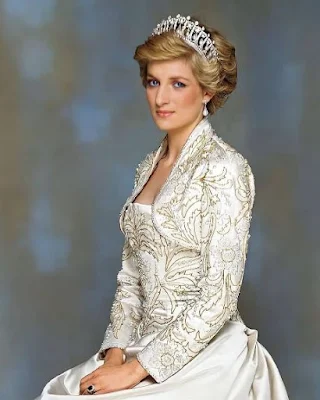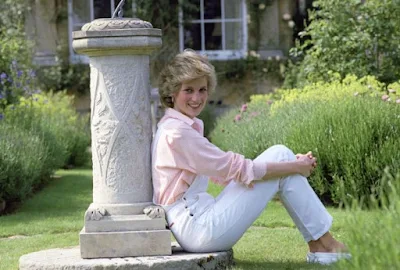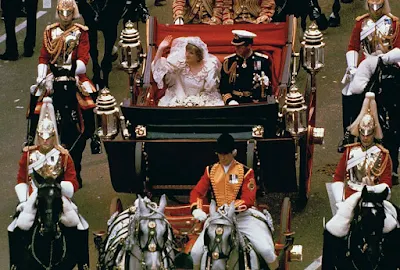Today is the 25th death anniversary of one of the most iconic figures in the 20th century, Diana, Princess of Wales. She was only 36 when she passed away on August 31, 1997, too young to die, and yet she had achieved so much, enough to leave an unforgettable footprint to the world.
To commemorate her legacy, Emma Hart, director of the McNeil Center for Early American Studies, offers her perspective on how history might view the late Princess of Wales, published in Penn Today.
Her two sons, Prince William, the Duke of Cambridge, and Prince Harry, the Duke of Sussex, speculated to be not on good terms since the Duke of Sussex's stepped back from his senior royal role in 2020, have made it clear they will observe their mother's 25th death anniversary in private.
 |
| Official portrait of The Princess of Wales wearing the Queen Mary's Lover's Knot Tiara, a wedding gift from The Queen. |
Now, 25 years after the tragic car crash in Paris, France that killed the beloved Princess of Wales, many have wondered how history has viewed her and how she helped transform the British monarchy into a modern institution.
Following her death, a lot of changes occurred within The Firm (Prince Philip's term for the British monarchy). Her eldest son, Prince William, became the first future British heir to marry a non-aristocratic commoner. Her former husband, Prince Charles, remarried making him the first divorced future British king to remarry in a civil wedding.
 |
| Princess Diana at Highgrove |
She helped mold Prince William into the person he had become, teaching him the value of compassion and how to be more in touch with the modern world and common people.
Prince William's upbringing and his approach to royal duties today, and how he raised his young family, have been partly shaped by the late Princess Diana.
She was also the most tactile parent to her boys. And was never shy in showing emotions in public, something that the Royal Family dreaded before the 1980s.
 |
| Princess Diana and the young Prince William |
People looked up to her because she was more attuned to the plight of the common people. She never hesitated to show kindness and compassion. And the public saw in her the downside of the fairytale.
The world loved everything about her, from her iconic fashion, hairstyle, and her mass appeal. She was photogenic, beautiful, compassionate, and had a warm personality.
Her unique brand of magic to connect with the masses allowed the public to delve better into the intricate world of royals, which, for a long time, was viewed as stiff and cold. Princess Diana ultimately changed the way people perceived the royals.
She was considered the biggest UK tourism draw during her lifetime, helping to boost Britain's tourism economy. She also reshaped the image of the royals, transforming them into celebrities without downgrading the prestige of the monarchy.
When her marriage to Prince Charles fell apart, she became the focus of public sympathy. Ordinary people sympathize with her plight as a scorned woman trapped in a loveless marriage.
As the public began to pour support for Princess Diana, the Royal Family had to realize that they couldn't shut her out. Diana made the British royal family rethink how they presented themselves to the public.
Camilla's royal title
Diana was so much loved by the public even years after her death that Camilla Parker-Bowles, avoided the title Princess of Wales, even if legally she is, following her marriage to Prince Charles, because the title was so much associated with Diana.
The palace courtiers feared that it might attract public scrutiny and hatred if Camilla will assume the Princess of Wales title, considering her role in the breakup of the marriage of the Prince and Princess of Wales. Thus, Camilla chose to use her husband's secondary title, the Duchess of Cornwall.
According to Emma Hart, the late Princess of Wales did force the British monarchy to move into the 21st century, so to speak. The way she molded her sons to be more in touch with the real world than be trapped in the tradition-laden lifestyle of the monarchy, helped the boys decide to take a spouse based on feelings rather than duty.
Prince William and Prince Harry's choices of non-aristocratic wives would have been unthinkable and impossible for royal blood princes decades ago.
It was the very reason why The Royal Marriages Act of 1772, which governed all royal marriages since the reign of King George II, was established to avoid inappropriate marriages between royal blood and commoners.
Although current historians have not yet thoroughly examined the real legacy and historical impact of Princess Diana on the British monarchy, according to Emma Hart, historians would probably view Diana as "a symbol of how the relationship between the royal family and British culture has changed".
"People were questioning whether the monarchy fit into modern British life, and Diana both prompted that question and answered it. Even some among the monarchy’s supporters were ready for a more human face to the institution and for a more useful monarchy", according to Hart.
Her memory will never be forgotten and will continue to be celebrated by those whose lives she had personally touched. Diana, Princess of Wales, was an unforgettable icon who will continue to inspire us in the years to come.











0 Comments